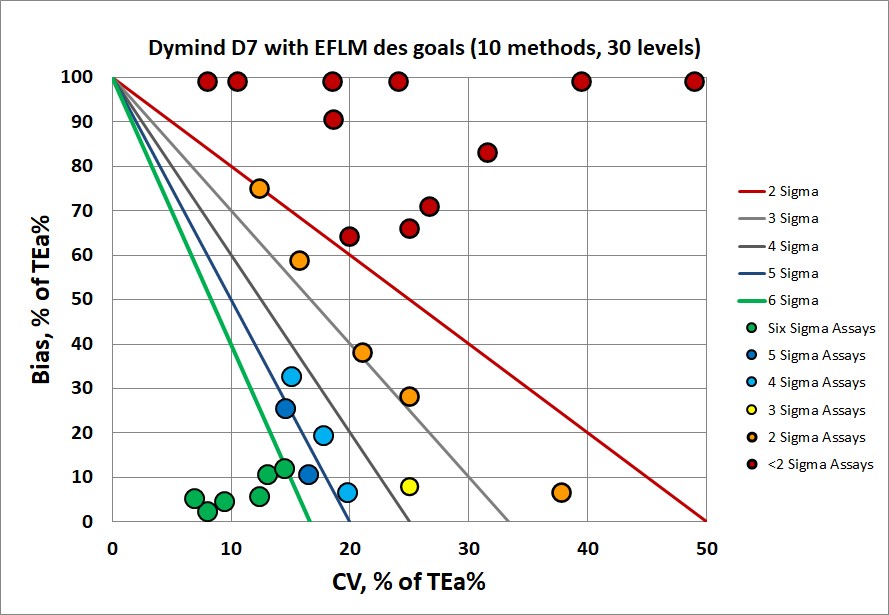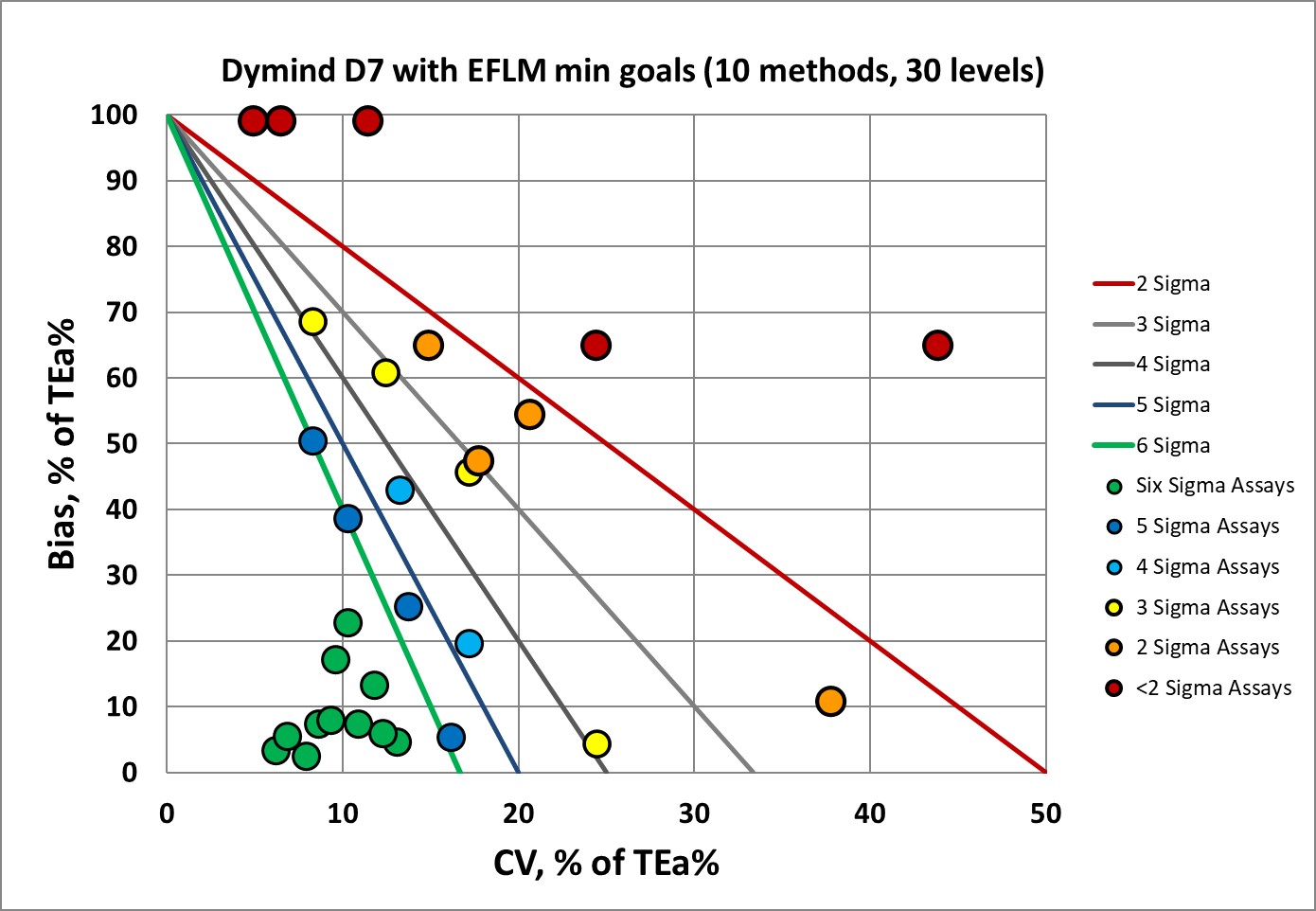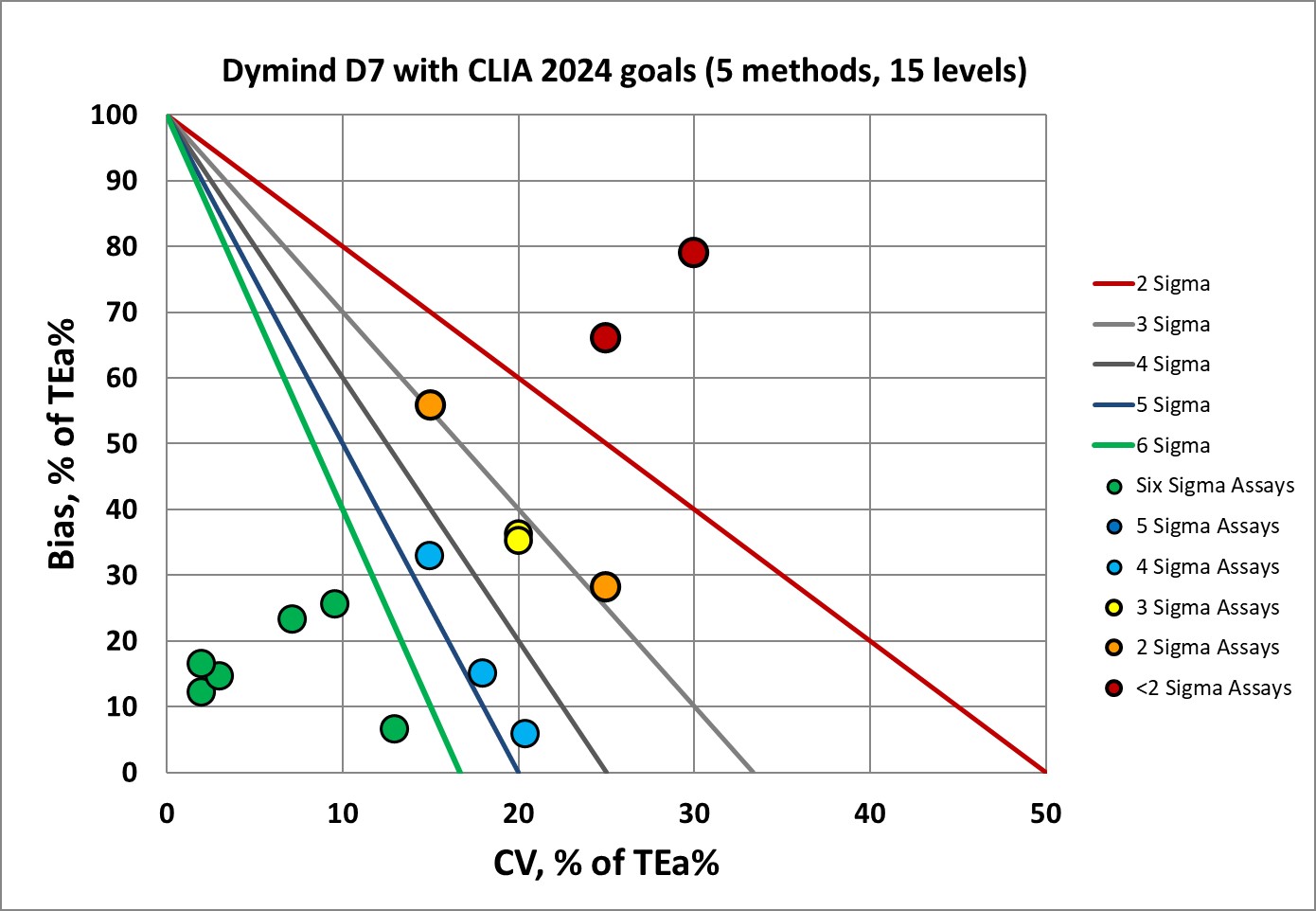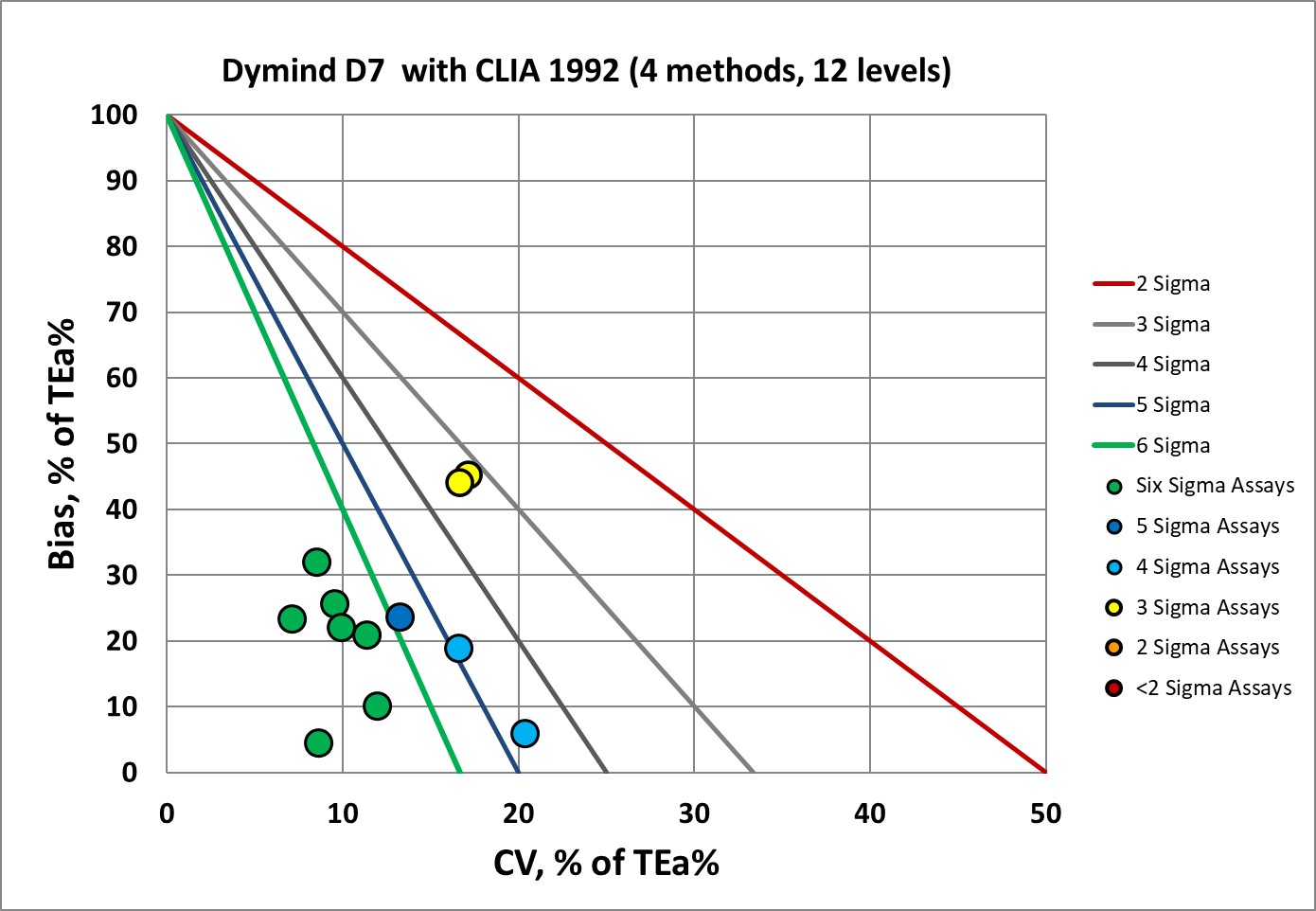Sigma Metric Analysis
Dymind D7-CRP hematology analyzer in Croatia, multimode analysis
Continuing in our analysis of hematology systems, we look at the impact of new CLIA and EFLM goals on the assessment of a Dymind D7-CRP automated analyzer.
Dymind D7-CRP automated hematology analyzer in Croatia, multimode analysis
September 2023
Sten Westgard, MS
See the other analyses in this series:
- Beckman Coulter DxC 700
- Abbott Alinity
- Siemens Atellica
- Siemens Atellica in Romania
- Siemens Atellica in Spain
- Siemens ADVIA 2120i
- Roche c501 in Turkey
- Roche c501 in Saudi Arabia
- MicroLab RX-50 in India
- Roche cobas 6000 immunoassays in Turkey
- Sysmex XN 350 in India
- Dymind DH 76 in Bulgaria
- Mindray 7500 in China
- Mindray BS 2000M in China
|
Sigma Quality Score: 2.5 Unhelpful. |
This Dymind D7-CRP data comes from the Children's Hospital Zagreb, Department of Laboratory Diagnostics, Croatia:
Analytical verification of the Dymind D7-CRP automated analyser, Merima Colic, Bojana Magdic, Monika Kolundzic, Jasna Lenicek Krleza. Biochem Med (Zagreb), 2023;33(2): 020703 https://www.biochemia-medica.com/en/journal/33/2/10.11613/BM.2023.020703
"[C]ontrol samples for haematological parameters were CBC-DH LOT DH2111 (R&D Systems, Minneaplis, USA) at three levels (low, normal, and high)....Analytical verification included estimation of repeatability, between run precision, within-laboratory precision, bias, and measurement uncertainty."
"Samples for method comparison were residual capillary and venous samples from pediatric patients in December 2021....Measurements on the analysers were performed no later than 2 hours after sample collection....Forty samples were specifically selected to cover the full measurement range of the Dymind D7-CRP....Method comparison between the Dymind D7-CRP and the Sysmex XN1000 for haematological parameters...was performed on 40 patient samples."
For once, we see the use of independent control materials, that's a plus. The comparison performed on pediatric samples is appropriate for the clinical use case at a children's hospital, but may not be as widely applicable.
We're using the within-laboratory precision estimates, and calculating bias from the Passing-Bablock regression equation, calculated at each of the control levels. We're not interested in the CRP method for this assessment, we're focusing only on the hematology parameters.
The TEa goals applied can be found on our Consolidated Hematology Performance Specifications page.
| TEST | Level | Slope | Y-int | % Bias | % CV |
| Hemoglobin | 57.00 | 1.05 | -4.65 | 3.2 | 1.20 |
| Hemoglobin | 131.00 | 1.05 | -4.65 | 1.5 | 0.80 |
| Hemoglobin | 168.00 | 1.05 | -4.65 | 2.2 | 0.60 |
| MCV | 80.20 | 0.96 | 2.24 | 1.2 | 0.20 |
| MCV | 88.10 | 0.96 | 2.24 | 1.5 | 0.30 |
| MCV | 95.10 | 0.96 | 2.24 | 1.6 | 0.20 |
| Platelets | 56.00 | 1.07 | -3.11 | 1.4 | 5.10 |
| Platelets | 256.00 | 1.07 | -3.11 | 5.8 | 1.80 |
| Platelets | 511.00 | 1.07 | -3.11 | 6.4 | 2.40 |
| RBC | 2.27 | 1.00 | 0.06 | 2.6 | 1.00 |
| RBC | 4.56 | 1.00 | 0.06 | 1.3 | 0.60 |
| RBC | 5.32 | 1.00 | 0.06 | 1.1 | 1.00 |
| WBC | 3.40 | 1.00 | -0.12 | 3.5 | 2.00 |
| WBC | 8.02 | 1.00 | -0.12 | 1.5 | 1.80 |
| WBC | 18.49 | 1.00 | -0.12 | 0.6 | 1.30 |
| Lymphocytes | 1.34 | 1.00 | 0.04 | 3.0 | 2.70 |
| Lymphocytes | 2.42 | 1.00 | 0.04 | 1.7 | 2.50 |
| Lymphocytes | 3.94 | 1.00 | 0.04 | 1.0 | 3.00 |
| Monocytes | 0.22 | 0.83 | 0.00 | 17.0 | 11.50 |
| Monocytes | 0.55 | 0.83 | 0.00 | 17.0 | 6.40 |
| Monocytes | 1.24 | 0.83 | 0.00 | 17.0 | 3.90 |
| Eosinophils | 0.17 | 0.96 | 0.01 | 1.9 | 10.70 |
| Eosinophils | 0.57 | 0.96 | 0.01 | 2.2 | 7.10 |
| Eosinophils | 1.70 | 0.96 | 0.01 | 3.4 | 4.10 |
| Basophils | 2.12 | 0.50 | -0.01 | 50.5 | 3.00 |
| Basophils | 5.82 | 0.50 | -0.01 | 50.2 | 1.70 |
| Basophils | 13.00 | 0.50 | -0.01 | 50.1 | 1.30 |
| Neutrophils | 1.67 | 1.02 | -0.06 | 1.6 | 3.40 |
| Neutrophils | 4.48 | 1.02 | -0.06 | 0.7 | 2.20 |
| Neutrophils | 11.61 | 1.02 | -0.06 | 1.5 | 1.90 |
Sigma-metrics according to EFLM-derived DESIRABLE performance specifications

Let's get the worst case out of the way. The EFLM desirable specifications used to be the de facto global standard, but have fallen out of favor due to their toughness.
For Dymind D7, 60% of the assay performance is in the 3 Sigma or worse zones. Monocytes, Basophils, MCV, and platelet count are all in the red zone.
No wonder EFLM recommends using the minimum performance specifications, not the desirable. So how does that look?
Sigma-metrics according to EFLM biological variation MINIMUM performance specifications

It's a big improvement, now only 30% of the performance is 3 Sigma and lower. Switching goals cuts the number of bad parameters in half. Monocytes and Basophils are still very low, but other parameters improved. Over a quarter of the performance achieves 6 Sigma. Neutrophlis, Lymphocytes, and WBC are all in the Bull's-eye.
Here's one of the most interesting new aspects of CLIA's new 2024 goals. Are they more or less demanding than EFLM goals?
Sigma-metrics according to CLIA 2024 performance specifications

The CLIA 2024 goals cast a favorable light on the Dymind D7, with only 40% of the performance at 6 Sigma, and just over 25%s at 3 Sigma or below. MCV and Platelets are in the Bull's-eye, as well as one level of WBC performance.
Just for a complete look, let's see how the oldest goals would have graded the Dymind D7.
Sigma-metrics according to CLIA 1992 performance specifications

If we apply the CLIA 1992 goals, the instrument looks really great. The most number of 6 Sigma analytes occur when these performance specifications are used. Almost 60% of the performance is in the Bull's-eye, and nothing is below 3 Sigma.
If only one could travel back in time, and operate this instrument back in the 1990's when the CLIA goals first came out.
Conclusion
The Dymind D7 is a new instrument on the market, and it faces stiff competition from the major diagnostic hematology manufacturers. With that kind of uphill climb, the D7 needs to demonstrate better performance, or at least comparable performance, with the major devices. Unfortunately, the data here is not showing that. The new goals are making harder for new devices to gain a foothold in the market.
